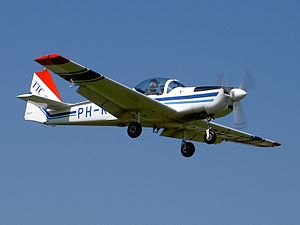
Aerobatics is the practice of flying maneuvers involving aircraft attitudes that are not used in conventional passenger-carrying flights. The term is a portmanteau of "aeroplane" and "acrobatics". Aerobatics are performed in aeroplanes and gliders for training, recreation, entertainment, and sport. Additionally, some helicopters, such as the MBB Bo 105, are capable of limited aerobatic manoeuvres. An example of a fully aerobatic helicopter, capable of performing loops and rolls, is the Westland Lynx.

The de Havilland Canada DHC-1 Chipmunk is a tandem, two-seat, single-engined primary trainer aircraft designed and developed by Canadian aircraft manufacturer de Havilland Canada. It was developed shortly after the Second World War and sold in large numbers during the immediate post-war years, being typically employed as a replacement for the de Havilland Tiger Moth biplane.

The Cessna T-41 Mescalero is a military version of the popular Cessna 172, operated by the United States Air Force and Army, as well as the armed forces of various other countries as a pilot-training aircraft.
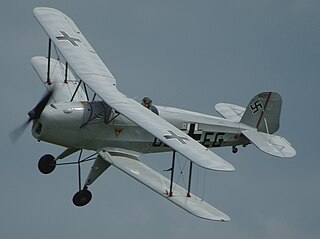
The Bücker Bü 131 Jungmann is a basic biplane trainer aircraft design and produced by the German aircraft manufacturer Bücker Flugzeugbau. It was the company's first aircraft, as well as being the final biplane to be produced in Germany.

The SIAI-Marchetti SF.260 is an Italian light aircraft which has been commonly marketed as a military trainer and aerobatics aircraft.
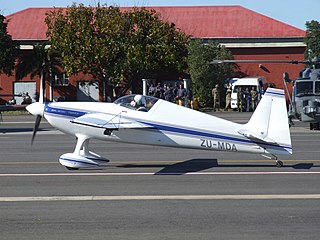
The Slick Aircraft Slick 360 is a South African aerobatics aircraft produced by the Slick Aircraft Company of Pretoria, South Africa. It is designed exclusively as an aerobatic competition aircraft, to compete in events such as the Advanced World Aerobatics Championships (AWAC).

The Extra Flugzeugbau EA300 is a two-seat aerobatic monoplane capable of Unlimited category competition. It was designed in 1987 by Walter Extra, a German aerobatic pilot, and built by Extra Flugzeugbau.

The Pitts Special is a series of light aerobatic biplanes designed by Curtis Pitts. It has accumulated many competition wins since its first flight in 1944. The Pitts biplanes dominated world aerobatic competition in the 1960s and 1970s and, even today, remain potent competition aircraft in the lower categories.

The Beechcraft Musketeer is a family of single-engined, low-wing, light aircraft that was produced by Beechcraft. The line includes the Model 19 Musketeer Sport, the Model 23 Musketeer, Custom and Sundowner, the Model 23-24 Musketeer Super III the retractable gear Model 24R Sierra and the military CT-134 Musketeer.

The Zlín Z 42 is a single-engine two-seat Czechoslovakian trainer aircraft manufactured by Moravan Otrokovice. A developed version, the Z 142, is the most popular aircraft variant in the manufacturer's aircraft line.

The Zlin Z-50 is an aerobatic sports airplane built by the Czechoslovakian company Zlin Aircraft.
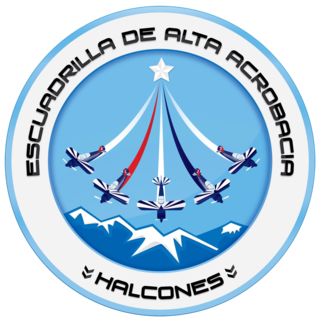
Escuadrilla de Alta Acrobacia Halcones, known simply as the 'Hawks' (Halcones), is an active group of nine officers of the Chilean Air Force who are trained specifically for aerobatics. One of the Halcones' signature moves is recreating the Chilean star in the air using smoke. The team may be likened to the British Royal Air Force's Red Arrows for their affinity for complex, high-risk, aviation-based manoeuvers.
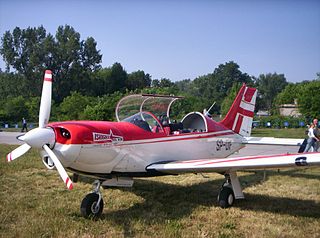
PZL M26 Iskierka or M26 Airwolf is a Polish trainer and aerobatic aircraft, designed at WSK PZL-Mielec.

The Beechcraft CT-134 Musketeer is a military training derivative of the Musketeer built by Beechcraft for the Canadian Armed Forces. The CT-134 was a single engine, low-wing, four-seat light aircraft with fixed landing gear and a limited aerobatic capability.

The Mudry CAP 10 is a two-seat training aerobatic aircraft first built in 1970 and still in production in 2007. The plane was developed from the Piel Super Emeraude and was born as the CP100. The name changed to CAP 10, CAP for 'Constructions Aéronautiques Parisiennes'. The CAP 10 was manufactured by Mudry in Bernay, France, bought by CAP Industries which then became Apex Aircraft. Following the bankruptcy of Apex in 2008, rights to produce spares were awarded to Dyn'Aviation. After the bankruptcy of DynAero in 2012, manufacture of spares was taken over by CEAPR in Darois.

The Lycoming IO-390 engine is a horizontally opposed, four-cylinder aircraft engine, manufactured by Lycoming Engines.
The Zenith CH 150 Acro Zenith is a Canadian single-engine, low wing, all-aluminum aircraft designed by Chris Heintz and produced by Zenair in kit form for amateur construction. The aircraft is intended for aerobatic use and was introduced at the Experimental Aircraft Association convention in 1980.

The Fournier RF7 was a single-seat motorglider designed and built in prototype form by René Fournier in France in 1970 and intended for series production by Sportavia-Pützer in Germany.
Swift Aircraft Limited is a British aerospace manufacturer that designs the Swift II aerobatic training aircraft.

The Spinks Akromaster is an aerobatic aircraft that was designed by Charlie Hillard.
